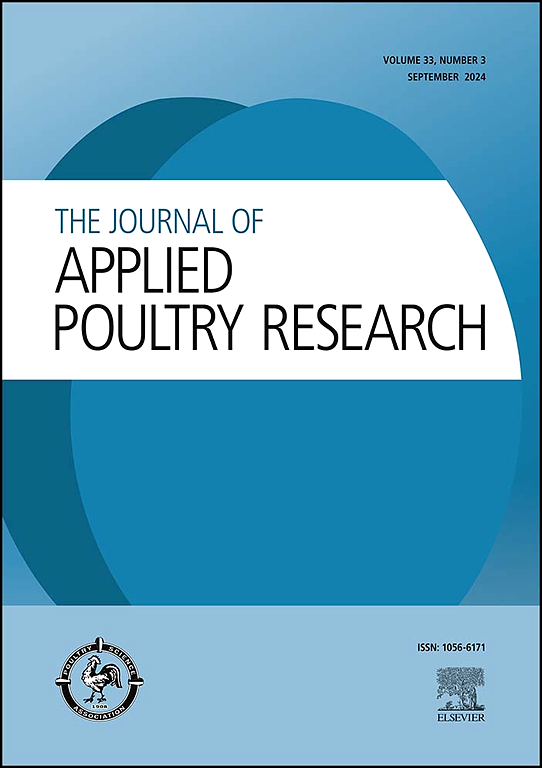Effect of sodium bisulfate and in-feed antimicrobial products on Salmonella Enteritidis survival and nutrient digestibility in contaminated broiler breeder diets
IF 2
3区 农林科学
Q2 AGRICULTURE, DAIRY & ANIMAL SCIENCE
引用次数: 0
Abstract
Antimicrobial products such as formaldehyde and formic acid can reduce pathogen levels in finished feed or the gastrointestinal tract. Some feed mill interventions decrease bacteria, but the degree of reduction, impact on digestibility, and interaction between other ingredients is unknown. We assessed two antimicrobial products with and without sodium bisulfate (SBS) as the primary sodium source in broiler breeder diets for efficacy against Salmonella Enteritidis (SE) load and impact on nutrient digestibility. Treatments included 1) a sodium bicarbonate (SBC) control diet, 2) SBC diet plus formaldehyde-based product (3 kg/MT), 3) SBC diet plus formic acid-based product (3 kg/MT), 4) SBS control diet (4 kg/MT), 5) SBS diet plus formaldehyde-based product (3 kg/MT), and 6) SBS diet plus formic acid-based product (3 kg/MT). Feed was contaminated with SE using meat and bone meal to achieve ∼106 cfu/g, and SE was enumerated at 0, 1, 2, and 7 d post-contamination. Uncontaminated diet samples were fed to Leghorn roosters and excreta samples were collected for nutrient analysis. SBS diets with the formaldehyde-based product had lower SE counts on d 0 compared to SBS control. This pattern continued with reduction in SE in both formaldehyde groups relative to other treatments, and by d 7 the Salmonella outcomes were zero in formaldehyde-treatments. TMEn was not different between treatments. Arginine and proline had lower digestibility coefficients in SBS diets with formic acid relative to SBS control. The tryptophan digestibility coefficient was higher in the SBS control diet relative to the SBC control. Collectively, these results indicate the primary sodium source had no negative impact on efficacy of Salmonella reduction in feed, however, an interaction may exist between formic acid and amino acid digestibility.
亚硫酸氢钠和饲料中抗菌产品对污染肉鸡饲粮中肠炎沙门氏菌存活和营养物质消化率的影响
甲醛和甲酸等抗菌产品可以降低成品饲料或胃肠道中的病原体水平。一些饲料厂干预措施可以减少细菌,但减少程度、对消化率的影响以及与其他成分的相互作用尚不清楚。研究了以亚硫酸氢钠(SBS)为主要钠源和不以亚硫酸氢钠(SBS)为主要钠源的两种抗菌产品在肉鸡种饲粮中抗肠炎沙门氏菌(SE)负荷的效果和对营养物质消化率的影响。处理包括:1)碳酸氢钠(SBC)对照饲粮、2)SBC饲粮加甲醛基产品(3 kg/MT)、3)SBC饲粮加甲酸基产品(3 kg/MT)、4)SBS对照饲粮(4 kg/MT)、5)SBS饲粮加甲醛基产品(3 kg/MT)、6)SBS饲粮加甲酸基产品(3 kg/MT)。用肉骨粉对饲料进行SE污染,达到~ 106 cfu/g,并在污染后0、1、2和7 d对SE进行计数。饲喂未受污染的日粮,收集粪便样本进行营养分析。与SBS对照组相比,添加甲醛基产品的SBS日粮在第0天的SE计数较低。与其他处理相比,这一模式继续存在,甲醛组的SE降低,到第7天,甲醛处理的沙门氏菌结果为零。两组间TMEn无显著差异。与对照组相比,添加甲酸的SBS饲粮中精氨酸和脯氨酸的消化率系数较低。SBS对照饲料的色氨酸消化系数高于SBC对照饲料。综上所述,主钠源对饲料中沙门氏菌的减少效果没有负面影响,但甲酸与氨基酸消化率之间可能存在交互作用。
本文章由计算机程序翻译,如有差异,请以英文原文为准。
求助全文
约1分钟内获得全文
求助全文
来源期刊

Journal of Applied Poultry Research
农林科学-奶制品与动物科学
CiteScore
4.10
自引率
10.50%
发文量
80
审稿时长
104 days
期刊介绍:
The Journal of Applied Poultry Research (JAPR) publishes original research reports, field reports, and reviews on breeding, hatching, health and disease, layer management, meat bird processing and products, meat bird management, microbiology, food safety, nutrition, environment, sanitation, welfare, and economics. As of January 2020, JAPR will become an Open Access journal with no subscription charges, meaning authors who publish here can make their research immediately, permanently, and freely accessible worldwide while retaining copyright to their work. Papers submitted for publication after October 1, 2019 will be published as Open Access papers.
The readers of JAPR are in education, extension, industry, and government, including research, teaching, administration, veterinary medicine, management, production, quality assurance, product development, and technical services. Nutritionists, breeder flock supervisors, production managers, microbiologists, laboratory personnel, food safety and sanitation managers, poultry processing managers, feed manufacturers, and egg producers use JAPR to keep up with current applied poultry research.
 求助内容:
求助内容: 应助结果提醒方式:
应助结果提醒方式:


